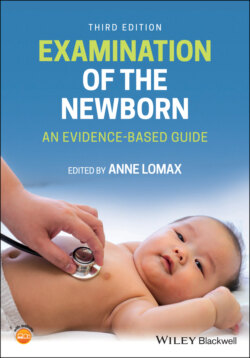Читать книгу Examination of the Newborn - Группа авторов - Страница 29
Early onset neonatal sepsis
ОглавлениеNewborn examiners must be continuously on the alert for possible risk factors for early onset neonatal sepsis. Early onset sepsis in the newborn is a significant contributor to perinatal mortality. One of the most common bacterial isolates is group B haemolytic streptococcus (GBS), which carries a mortality of 6% in term infants and 18% in preterm infants (NICE 2017). Maternal infection during the antenatal period must be actively treated with antibiotic therapy. Treatment with antibiotics for the newborn may also be required but is risk dependent or if the newborn is symptomatic (NICE 2012; RCOG 2017). Ohlsson and Shah (2009) inferred that intrapartum antibiotic therapy does reduce the risk of early onset GBS in the newborn.
In the case of pre‐labour prolonged rupture of membranes (PROM), the length of time must be noted (NICE 2012). The risk of early onset GBS infection in the newborn is greater in women with PROM (NICE 2012; RCOG 2017). In the absence of any other symptoms, true maternal pyrexia in labour must never be ignored. In addition, there was no strong evidence to recommend antibiotic prophylaxis for newborns of women with PROM in labour (NICE 2012).
Conversely, the symptomatic newborn must commence antibiotic therapy and admission to the neonatal unit for further diagnostics. Every newborn must be treated on an individual basis, depending on the risk factors presenting. Multiple risk factors will necessitate newborn screening for infection and the commencement of antibiotic prophylaxis until blood culture results become available. Local policy on the prevention and detection of early onset sepsis in the newborn must reflect the red flag and non‐red flag risk indicators as detailed in the NICE guidance for neonatal infection early onset (NICE 2012) available at https://www.nice.org.uk/guidance/cg149. The NICE guidance advocates the avoidance of routine antibiotic therapy.
It is estimated that 90% of newborns with early onset sepsis will be symptomatic within 12 hours of birth (NICE 2017). Therefore, all newborns with risk factors for early onset infection must receive close observation as indicated on the local neonatal early warning score (NEWS) chart. A framework for the use of the neonatal early warning trigger and track (NEWTT) chart can be found on the British Association of Perinatal Medicine (BAPM) website: https://www.bapm.org/resources/38‐newborn‐early‐warning‐trigger‐track‐newtt‐a‐framework‐for‐practice‐2015.
The NIPE examiner must ensure that the observations are documented on the NEWS chart and reviewed within the context of the examination and assessment of the overall health of the newborn.
